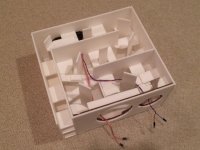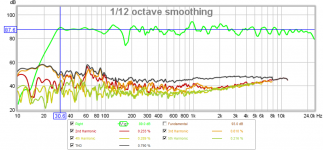Yes, the tapering on my design puts fb at about 56Hz for a 48in or 1.22m length TL which would have been 70Hz for a straight tube.
The dip between the two impedence peaks shows the fb:

The dip between the two impedence peaks shows the fb:

Reducing each line width towards terminus -is it as effective as angling each section?
Last edited:
The 1-d lumped element model that Akabak uses knows no difference, and that is supported by the measurements. The step changes will serve as a mechanical low pass filter, whereas a long tapered smooth tube will let harmonics escape easier like a tapered bore flute.
There's another relatively low cost 5" worth considering, the Peerless 830860. Not too dissimilar specs. In the uk it's £35 each inc delivery but for that u get a decent cast frame and it looks rather nice too. Troels gave it the thumbs up.
Last edited:
P830860 is indeed a nice driver. I like poly cone mid bass drivers for how smooth they are and this one is no different. Flat with not much of an issue with break up peaks. That would save me at least one notch filter in my above complex passive XO. It is about 2dB lower sensitivity though at 87.1dB at 2.83v. I like the looks and the cast frame. The TS data of Peerless products is usually accurate and representative. With Qts of 0.47, it is the same as the AC130F1 as measured by me for 3 samples (not quoted in spec sheet as 0.29). A dual driver would probably work really well.
There's two sets of parameters for that driver. One says over 88db (2.83). Maybe the newer Chinese made ones are slightly different and not as sensitive
There's two sets of parameters for that driver. One says over 88db (2.83). Maybe the newer Chinese made ones are slightly different and not as sensitive
Here is the spec sheet I am going from, rev 1 dated 2009.
http://www.parts-express.com/pedocs/specs/264-1080-peerless-830860-specifications.pdf
These are $43 ea in the US and worth trying.
Another one I want to try is the RS150P-8. Same price, cast frame, and almost 90dB sensitive with more xmax and lower Qts. Dayton's TS values for RS series are also generally accurate. It does have a peak at 5.6k though as it is a paper cone.
http://www.parts-express.com/pedocs/specs/rs150p-8-specifications--295-363.pdf
Xrk approx how far down the line is the driver? Looks about one fifth - I've seen some recent TL builds putting the driver approx one quarter down so wondering what these different approaches mean
Sent from my iPhone using Tapatalk
1/5th suppresses 5th harmonic
1/3rd suppresses 3rd harmonic
In between has a midway effect.
MJKs alignment tables really help to define the correct CSA and Dz offset.
I recommend them, If you can bear to use a calculator. I never used his Mathcad sheets, just the alignment tables.
That PMC looks to me like it is rather compromised in the volume (CSA of the line). I doubt it is optimal.
Damped until impedance is a single peak, may well be more optimal for that particular speaker. (Xs implementation 'looks' like a 2:1 taper line...could be a trick of the eye...and certainly looks derived from MJK more than PMC)
Just for interest (if there is any), my MJK based TL is a 10:1 taper, 3.2 sq.in terminus, Fb of ~40Hz, 1 metre tall. It has no fold and is 'stepped' for half the line length (LPF). It is designed for a 5" low Fs moderate Q and Vas. And it works every bit as well as it was designed to!
Last edited:
My TL was my own from scratch using 3:1 but in non linear taper ratio of 5:4:3:1.5 for a mild constriction on last leg to pull tuning a bit lower and give proper volume needed for driver Vas. The only thing similar to PMC is overall look, use of lots of damping, and 48in line length.
My TL was my own from scratch using 3:1 but in non linear taper ratio of 5:4:3:1.5 for a mild constriction on last leg to pull tuning a bit lower and give proper volume needed for driver Vas. The only thing similar to PMC is overall look, use of lots of damping, and 48in line length.
The most interesting part about MJKs work is the effect of taper ratio (positive or negative) on the spread and distribution of harmonics.
An exponential/parabolic taper is interesting for sure. I stayed with linear to avoid any rapid changes in CSA that stepped linear may cause,especially at the bends.
Second unit for stereo in progress
The second TL speaker is now awaiting for glue to dry on final side panel capping operation. I changed the bracing scheme a bit and built it from the outside in so that channel depths are defined by small spacers. Much more precise this way and went quickly. Not shown (for clarity) are foam damping pads behind driver and stuffing which resemble first unit.
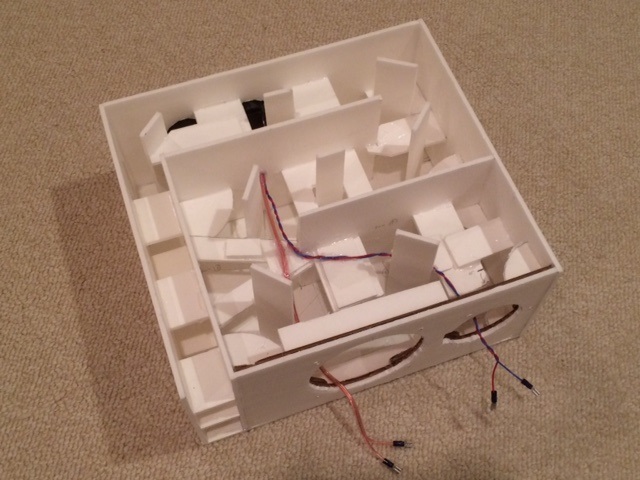
The second TL speaker is now awaiting for glue to dry on final side panel capping operation. I changed the bracing scheme a bit and built it from the outside in so that channel depths are defined by small spacers. Much more precise this way and went quickly. Not shown (for clarity) are foam damping pads behind driver and stuffing which resemble first unit.

Attachments
Thanks, more impressive is the fact that the speaker without drivers weighs maybe 200 grams (foam and cardboard with glue). The copious bracing is critical to keep it from resonating like a musical instrument body.
I will fire it up later tonight for first sound.
I will fire it up later tonight for first sound.
Stereo Unit 2 Measurement
Here is the completed stereo pair. I installed a second layer of foam core on the baffle to rebate the drivers flush.
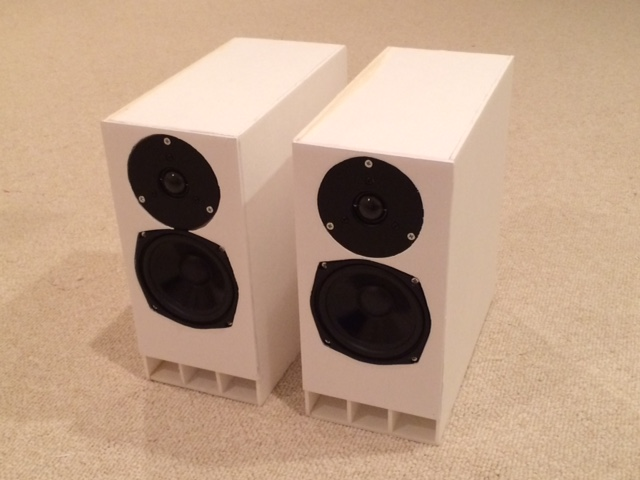
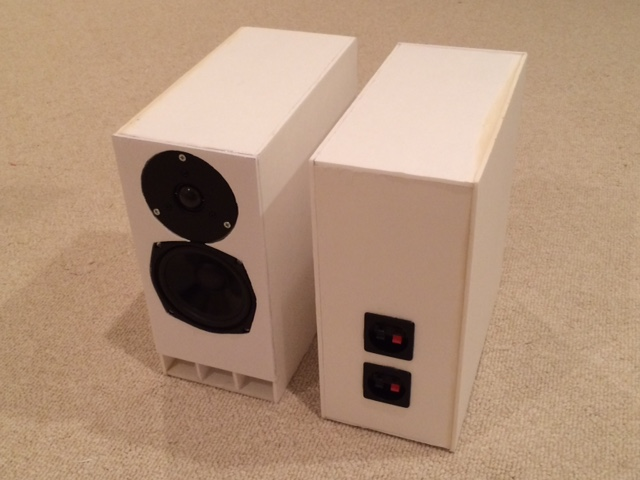
The frequency response between the two are pretty well matched left and right (-3dB is at 47Hz with a 3dB low shelf boost at 80Hz, f3 is 55Hz w/o boost):

Here is the measured phase of unit 2:
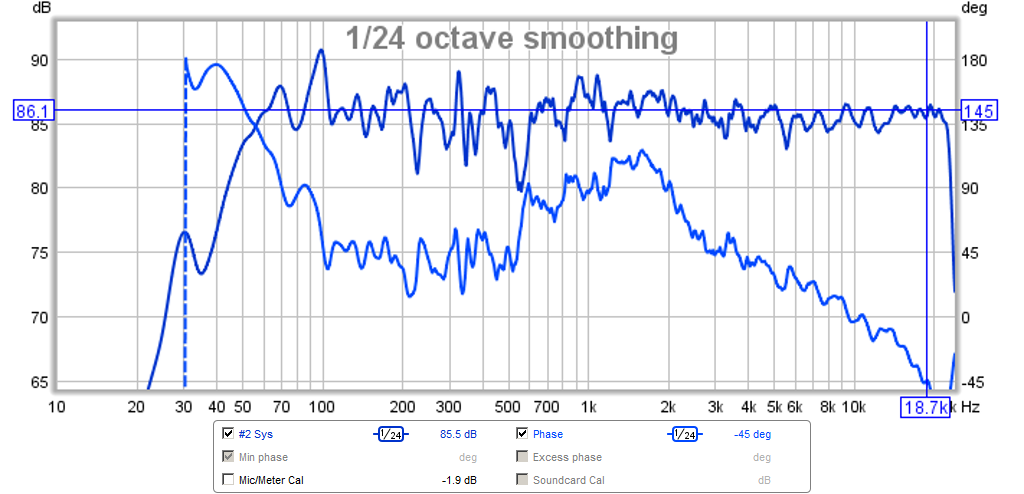
Phase of unit 1:
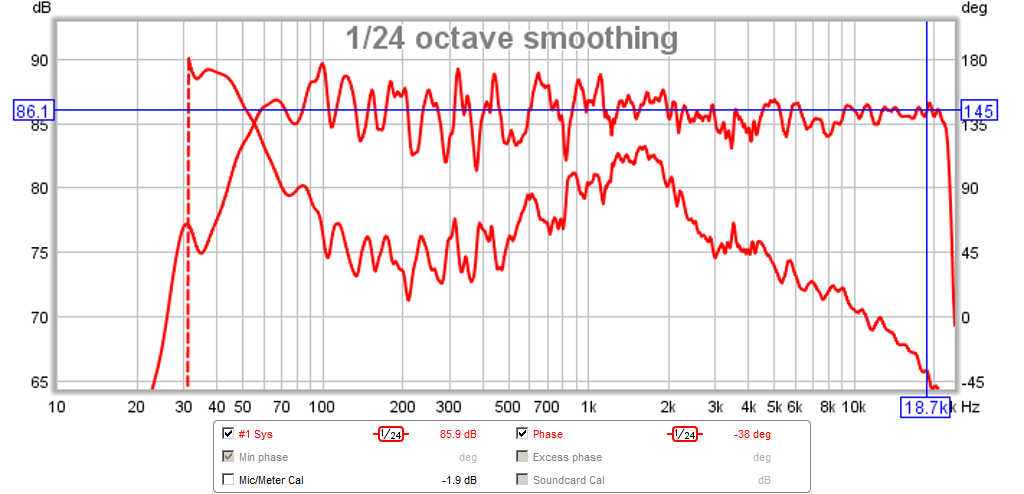
Distortion of unit 2 at typical listening levels:
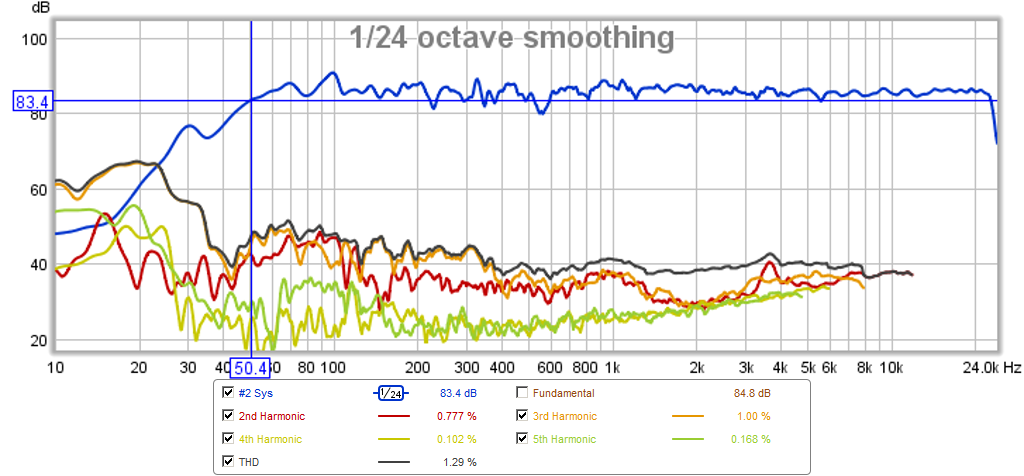
Impulse Response of unit 2:
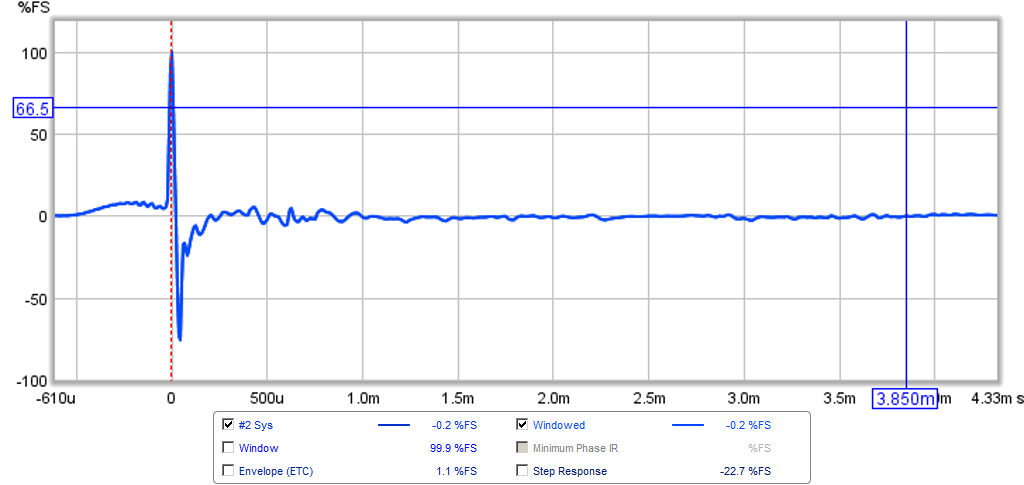
How do they sound in stereo? Fantastic! The imaging is very good, the bass is tight and articulate, highs are exceptional clean and brilliant without being fatiguing. Impulse shows no major ringing issues.
Here is the completed stereo pair. I installed a second layer of foam core on the baffle to rebate the drivers flush.


The frequency response between the two are pretty well matched left and right (-3dB is at 47Hz with a 3dB low shelf boost at 80Hz, f3 is 55Hz w/o boost):

Here is the measured phase of unit 2:

Phase of unit 1:

Distortion of unit 2 at typical listening levels:

Impulse Response of unit 2:

How do they sound in stereo? Fantastic! The imaging is very good, the bass is tight and articulate, highs are exceptional clean and brilliant without being fatiguing. Impulse shows no major ringing issues.
Attachments
-
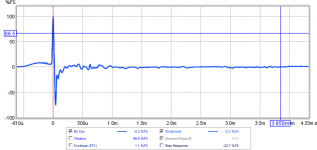 pmc-tl-no-2-ir.png51.9 KB · Views: 1,341
pmc-tl-no-2-ir.png51.9 KB · Views: 1,341 -
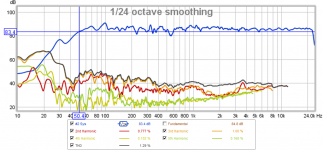 pmc-tl-no-2-hd.png153.3 KB · Views: 1,843
pmc-tl-no-2-hd.png153.3 KB · Views: 1,843 -
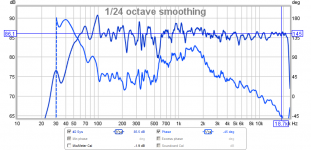 pmc-tl-no-2-phase.png129.5 KB · Views: 1,341
pmc-tl-no-2-phase.png129.5 KB · Views: 1,341 -
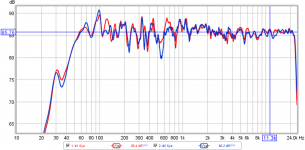 pmc-tl-stereo-freq-compare.png111.4 KB · Views: 4,698
pmc-tl-stereo-freq-compare.png111.4 KB · Views: 4,698 -
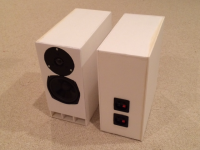 PMC-TL-Stereo-Build-2.PNG401.1 KB · Views: 1,377
PMC-TL-Stereo-Build-2.PNG401.1 KB · Views: 1,377 -
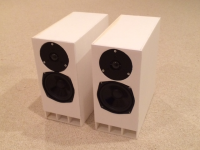 PMC-TL-Stereo-Build-1.PNG388.7 KB · Views: 3,513
PMC-TL-Stereo-Build-1.PNG388.7 KB · Views: 3,513 -
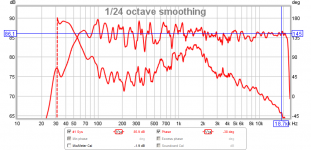 pmc-tl-no-1-phase.png113.6 KB · Views: 1,592
pmc-tl-no-1-phase.png113.6 KB · Views: 1,592
Last edited:
Sound Clips in Stereo at Desk LP
I set up these speakers as my desk monitors. They sound amazingly good - great bass extension, clear articulate mid bass and nice highs. Capable of 91dB SPL with distortion below 2%. Even plays dance tracks with a heavy bass beat with no problems. Flat from 30Hz to 20kHz.
Change .asc extension to .mp3 to listen.
Here is frequency response and distortion from one channel at 88dB, and 91dB in stereo. Dip at 170Hz is desk bounce.
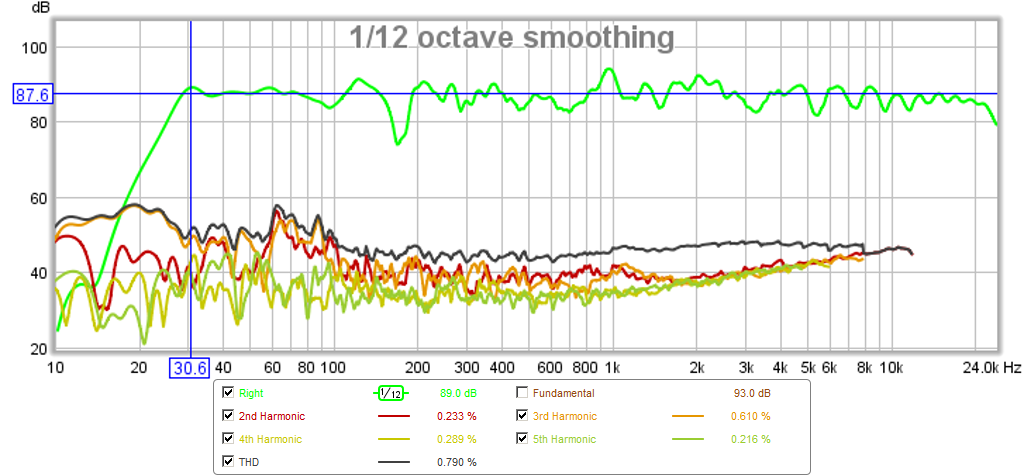
I set up these speakers as my desk monitors. They sound amazingly good - great bass extension, clear articulate mid bass and nice highs. Capable of 91dB SPL with distortion below 2%. Even plays dance tracks with a heavy bass beat with no problems. Flat from 30Hz to 20kHz.
Change .asc extension to .mp3 to listen.
Here is frequency response and distortion from one channel at 88dB, and 91dB in stereo. Dip at 170Hz is desk bounce.

Attachments
Last edited:
Thanks for listening Byrtt. I think the takeaway for me was that clip 3 was playable at pretty high volume without bottoming out the woofer and making a nasty EOL (end of limit) sound. 🙂
Laminate the outside of the cabinets with Formica and you have a compact, TL equivalent of the old Wharfedale 708 foam-panel speakers from the 80s.
Not sure how the Wharfedale 708, besides the foam core, resembles this TL. I would imagine the sound and performance to be totally different. First thing that surprises me is how loud this can get, and get there cleanly. The damped TL does a nice job of controlling cone motion and providing the bass in the lower octave. I don't think a sealed or BR can do the same as efficiently.
I may try laminating the outside with thin 3/16in Sureply panels like I did on the 10F/RS225 monitor baffle. But quite happy with the sound and how lightweight the speaker is.
I may try laminating the outside with thin 3/16in Sureply panels like I did on the 10F/RS225 monitor baffle. But quite happy with the sound and how lightweight the speaker is.
- Home
- Loudspeakers
- Multi-Way
- Low-Cost PMC-inspired TL Monitor with DC130A and DC28F
